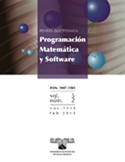Eficiencia del Método de Optimización del Diseño de Fidelidad Variable con Modelos de Complejidad Variable
DOI:
https://doi.org/10.30973/progmat/2015.7.1/7Palabras clave:
Métodos de escalamiento, Diferente grado de no-linealidad, Diferente número de variables de diseño, Fidelidad variableResumen
El objetivo de esta investigación es mejorar la comprensión del algoritmo de fidelidad variable y de diversos métodos de escalamiento a través de tres problemas. Los primeros dos problemas son analíticos, y el tercero es un problema de optimización structural. Los problemas han sido construidos especificamente para comprender el funcionamiento del algoritmo con modelos (alta y baja fidelidad) de diferente grado de no-linealidad y diferente número de variables de diseño. El rendimiento del algorimo al usar diversos métodos de escalamiento de primero y segundo orden (aditivo y multiplicativo), es comparado con el rendimiento de usar programación cuadrática secuencial solamente sobre el modelo de alta fidelidad. La principal contribución de esta investigación es la comprensión ganada con los problemas propuestos, lo cual puede extenderse a otros problemas, sobre el alcance y limitandes del algoritmo, y la elección del método de escalamiento más apropiado dependiendo del caso de studio que se tenga. Además, los resultados muestran como una reducción del tiempo de diseño puede obtenerse, mientras se reduce el número de evaluaciones al modelo de alta fidelidad y se alcanza convergencia.
Citas
Alexandrov, N. M., Dennis, J. E., Lewis, R. M., and Torczon, V. A Trust-Region Framework for Managing the Use of Approximation Models in Optimization. Structural Optimization. 1998, 15(1), 16-23. https://doi.org/10.1007/BF01197433
Rodriguez, J. F., Renaud, J. E., and Watson, L. T. Convergence of Trust Region Augmented Lagrangian Methods Using Variable Fidelity Approximation Data. Structural Optimization. 1998, 15(3-4), 141-156. https://doi.org/10.1007/BF01203525
Rodriguez, J. F., Renaud, J. E., and Watson, L. T. Trust Region Augmented Lagrangian Methods for Sequential Response Surface Approximation and Optimization. ASME Journal of Mechanical Design. 1998, 120(1), 58-66. https://doi.org/10.1115/DETC97/DAC-3773
Wujek, B. A. and Renaud, J. E. A New Adaptive Move-Limit Management Strategy for Approximate Optimization, Part 1. AIAA Journal. 1998, 36(10), 1911-1921. https://doi.org/10.2514/2.285
Wujek, B. A. and Renaud, J. E. A New Adaptive Move-Limit Management Strategy for Approximate Optimization, Part 2. AIAA Journal. 1998, 36(10), 1922-1937. https://doi.org/10.2514/2.287
Perez, V. M., Renaud, J. E., and Watson, L. T. An Interior-Point Sequential Approximate Optimization Methodology. Structural Optimization. 2004, 27(5), 360-370. https://doi.org/10.1007/s00158-004-0395-y
Bakr, M. H., Bandler, J. W., Madsen, K., Rayas-Sánchez, J. E., and Søndergaard, J. Review of the Space Mapping Approach to Engineering Optimization and Modeling. Optimization and Engineering. 2000, 1(3), 241-276. https://doi.org/10.1023/A:1010000106286
Qian, Z., Seepersad, C. C., Joseph, V. R., Allen, J. K., and Wu, C. F. J. Building Surrogate Models Based on Detailed and Approximate Simulations. ASME Journal of Mechanical Design. 2006, 128(4), 668-677. https://doi.org/10.1115/1.2179459
Osio, I. G. and Amon, C. H. An Engineering Design Methodology with Multistage Bayesian Surrogates and Optimal Sampling. Research in Engineering Design. 2005, 8(4), 189-206. https://doi.org/10.1007/BF01597226
Alexandrov, N. M. and Lewis, R. M. An Overview of First-Order Model Management for Engineering Optimization. Optimization and Engineering. 2001, 2, 413-430. https://doi.org/10.1023/A:1016042505922
Thokala, P. and Martins J. R. R. A. Variable-Complexity Optimization Applied to Airfoil Design. Engineering Optimization. 2007, 39(3), 271-286. https://doi.org/10.1080/03052150601107976
Eldred,M.S.,Giunta,A.A., and Collis,S.S.Second-Order Corrections for Surrogate-Based Optimization with Model Hierarchies. In: Proceedings of the 10th AIAA/ISSMO Multidisciplinary Analysis and Optimization Conference. Albany, New York, 2004. https://doi.org/10.2514/6.2004-4457
Gano, S. E., Renaud, J. E., and Sanders, B. Variable Fidelity Optimization Using a Kriging Based Scaling Function. In: Proceedings of the10th AIAA/ ISSMO Multidisciplinary Analysis and Optimization Conference. Albany, New York, 2004. https://doi.org/10.2514/6.2004-4460
Giunta, A. A. and Eldred, M. S. Implementation of a Trust Region Model Management Strategy in the Dakota Optimization Toolkit. In: Proceedings of 8th AIAA/NASA/ISSMO Symposium on Multidisciplinary Analysis and Optimization. Long Beach, CA, 2000. https://doi.org/10.2514/6.2000-4935
Alexandrov, N. M. and Lewis, R. M. An Overview of First-Order Model Management for Engineering Optimization. Optimization and Engineering. 2001, 2, 413-430. https://doi.org/10.1023/A:1016042505922
Haftka, R. T. Combining Global and Local Approximations. AIAA Journal. 1991, 29(9), 1523-1525. https://doi.org/10.2514/3.10768
Chang, K. J., Haftka, R. T., Giles, G. L., and Kao, P.-J. Sensitivity-Based Scaling For Approximating Structural Response. Journal of Aircraft. 1993, 30(2), 283-288. https://doi.org/10.2514/3.48278
Eldred, M. S., Giunta, A. A., and Collis, S. S. Second-Order Corrections for Surrogate-Based Optimization with Model Hierarchies. In: Proceedings of the 10th AIAA/ISSMO Multidisciplinary Analysis and Optimization Conference. Albany, New York, 2004. https://doi.org/10.2514/6.2004-4457
Gano, S. E., Perez, V. M., and Renaud, J. E. Multi-Objective Variable-Fidelity Optimization of a Morphing Unmanned Aerial Vehicle. In: Proceedings of the 45th AIAA/ASME/ASCE/AHS/ ASC Structures, Structural Dynamics & Materials Conference. Palm Springs, CA, 2004. https://doi.org/10.2514/6.2004-1763
Lewis, R. M. and Nash, S. G. A Multigrid Approach to the Optimization of Systems Governed by Differential Equations. In: Proceedings of the 8th AIAA/USAF/NASA/ISSMO Symposium on Multidisciplinary Analysis and Optimization. Long Beach, CA, 2000. https://doi.org/10.2514/6.2000-4890
Barnes, G. K. Master’s thesis. The University of Texas. Austin, Texas, 1967.
Wujek, B. A., Renaud, J. E., Batill, S. M. A Concurrent Engineering Approach for Multidisciplinary Design in a Distributed Computing Environment. In: N. Alexandrov, M. Y. Hussaini, eds., Multidisciplinary Design Optimization: State-of-the-Art. 1997, 80, 189–208.
Wujek, B. A., Renaud, J. E., Batill, S. M., Brockman, J. B. Concurrent Subspace Optimization Using Design Variable Sharing in a Distributed Design Environment. Concurrent Engineering. 1996, 4(4), 361-377. https://doi.org/10.1177/1063293X9600400405
Descargas
Publicado
Cómo citar
Número
Sección
Licencia
Derechos de autor 2015 Programación Matemática y Software

Esta obra está bajo una licencia internacional Creative Commons Atribución 4.0.
Usted es libre de:
 |
Compartir — compartir y redistribuir el material publicado en cualquier medio o formato. |
 |
Adaptar — combinar, transformar y construir sobre el material para cualquier propósito, incluso comercialmente. |
Bajo las siguientes condiciones:
 |
Atribución — Debe otorgar el crédito correspondiente, proporcionar un enlace a la licencia e indicar si se realizaron cambios. Puede hacerlo de cualquier manera razonable, pero de ninguna manera que sugiera que el licenciador lo respalda a usted o a su uso. |
| Sin restricciones adicionales: no puede aplicar términos legales o medidas tecnológicas que restrinjan legalmente a otros a hacer cualquier cosa que permita la licencia. |










